Once I bought a Manfrotto pistol-grip-upside-down ball head, with the typical Manfrotto camera plate. After a while I wanted something more robust, and I choose for an Arca-Swiss compatible ball head from Kirk Enterprises, and a matching L-bracket. The latter was one of the best choices I made.
I used to get a lot of questions about that piece of metal I had underneath my camera. A lot of photographers never heard about a L-bracket before. This was somewhere around 2007, perhaps even earlier. After a while I got tired of the terrible camera plates of the Manfrotto 322RC2 ball head and started looking for something else. I cannot remember how I discovered the L-brackets, but it seemed to be exactly what I needed. I spend a lot of money for a Kirk Enterprises ball head, and a matching L-bracket for my Canon EOS 20D.

I used a Canon EOS 5D for a while, together with a battery grip. Once the RRS L-bracket was mounted, it never came off. Except when I needed to clean the camera.
The L-bracket became part of my cameras since that moment. With every new camera, a new L-bracket came with it. I changed from Kirk Enterprises to Really Right Stuff (RRS) because it had a better design for the Canon EOS 1D mark III, and I stayed with RRS ever since. Even when the much cheaper brands started to sell L-brackets of their own, I stayed with the perfect designed RRS.

My Canon EOS 1D mark III also had a L-bracket. It gave a lot of protection from damage when placing the camera on stage during my concert photography, just like in this example.
About Camera Plates for Tripods
Why did I choose that expensive L-bracket? That is one of the questions I got frequently. To answer that I would like to look at the way we connect a camera to a tripod. It used to be a simple screw, but as time passed manufacturers invented the camera quick connection plate. You would connect a simple plate to the camera, that would click into a slot on the tripod. It was easy and quick. That system was perfected over time and now it is used for almost every tripod.
Unfortunately every manufacturer made its own design, that was not compatible with any other brand. One of those systems was the Arca-Swiss type connection, and eventually that system became the most common one.

The difference between a normal cameraplate and a L-bracket. This L-bracket fits the camera like a glove
I find the Arca-Swiss system very well designed, making it possible to integrate the camera plate in such a way, that it becomes a part of the camera itself. It does not stick out in any way like many other types of camera plates. The design of the Arca-Swiss makes it also possible to prevent the plate from rotating when a camera is placed in the portrait orientation on a tripod. If the common plate is not fastened enough, it can rotate. Especially when a large or heavy lens is connected to the camera. In the worst case scenario a camera can get loose and fall.
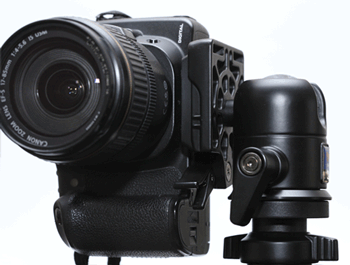
When a normal cameraplate is not connected secure enough, due to the weight of the camera and lens it could unintentionally rotate.

The L-bracket is designed for a specific camera model, like this Kirk Enterprises L-bracket for the Canon EOS 20D. There is no risk this plate will rotate when connected to the tripod.
The design of a good the Arca-Swiss compatible camera plate can prevent the rotation of the camera in portrait position. It was something that I liked very much. But the L-bracket has another benefit that would prevent this unwanted rotation from the camera even more.
A L-bracket is nothing more than a well-designed L-shaped metal camera plate. It not only fits underneath the camera, but also to the side of the camera. This way, the camera can be connected to the tripod in the normal landscape position, but also in the portrait position without the need for flipping over the ball head.
Using a L-Bracket
The real reason for a L-bracket becomes obvious when we connect a camera to the ball head. In landscape position it is not much different from a normal camera plate. But when you need to place the camera in portrait position, a few things will happen with a normal camera plate. First of all, the camera with lens will be tilted 90° towards the left or right of the ball head. With a heavy camera, or a light tripod, the setup may become unstable. But also the composition will change because the camera had a different position.
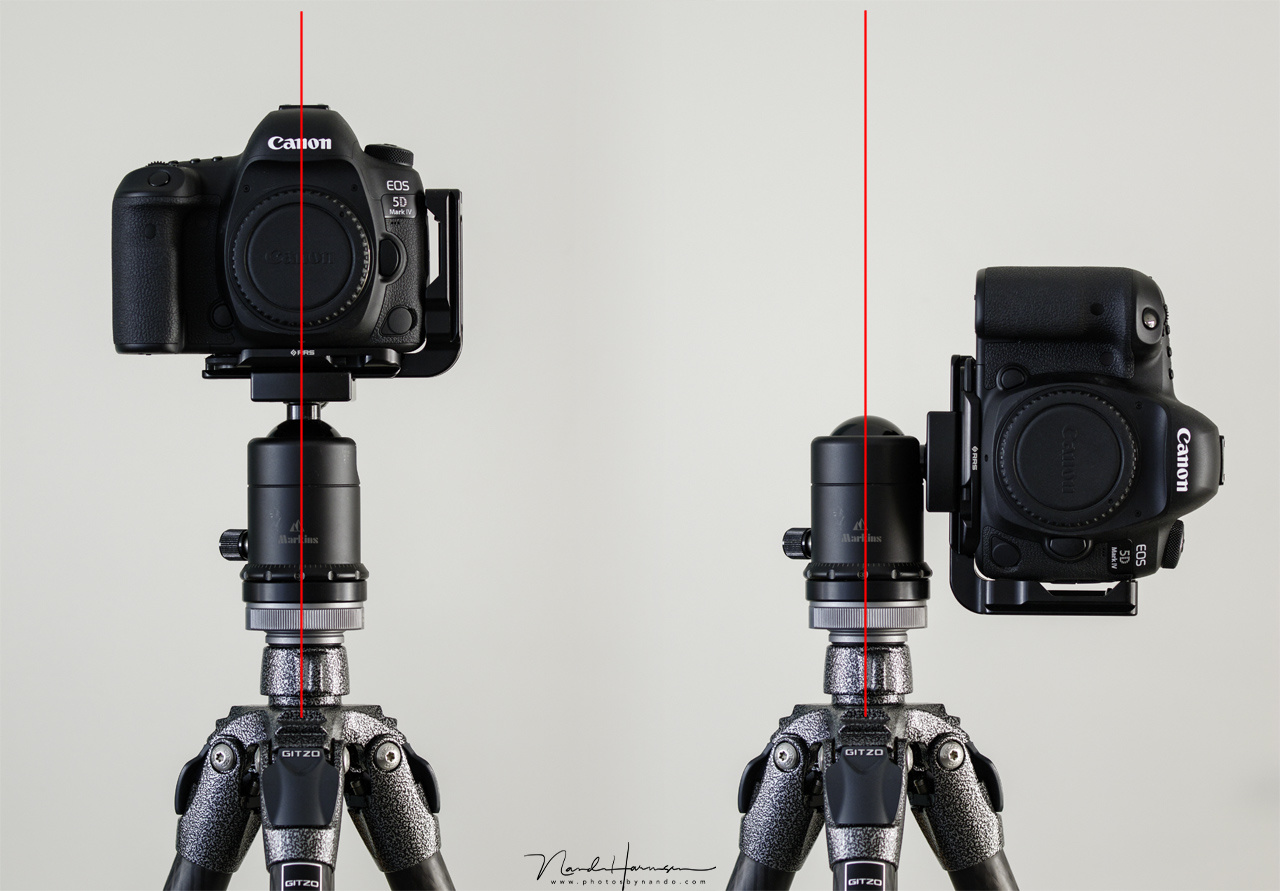
With a regular camera plate it is necessary to flip the camera to the side, placing it next to the tripod. Unless you use a sturdy tripod, the setup may become unstable. You also need to correct the composition offset.
When we use a L-bracket, nothing has changed with the landscape position. When we want to change it into portrait position, we have to disconnect the camera from the ball head, rotate the camera 90°, and connect it again to the ball head. This way, the weight of the camera and lens is still right above the center of the tripod, keeping the setup well in balance. But also the composition remains the same. Sure, it has changed in orientation, but the position of the camera has not changed. It just rotated.
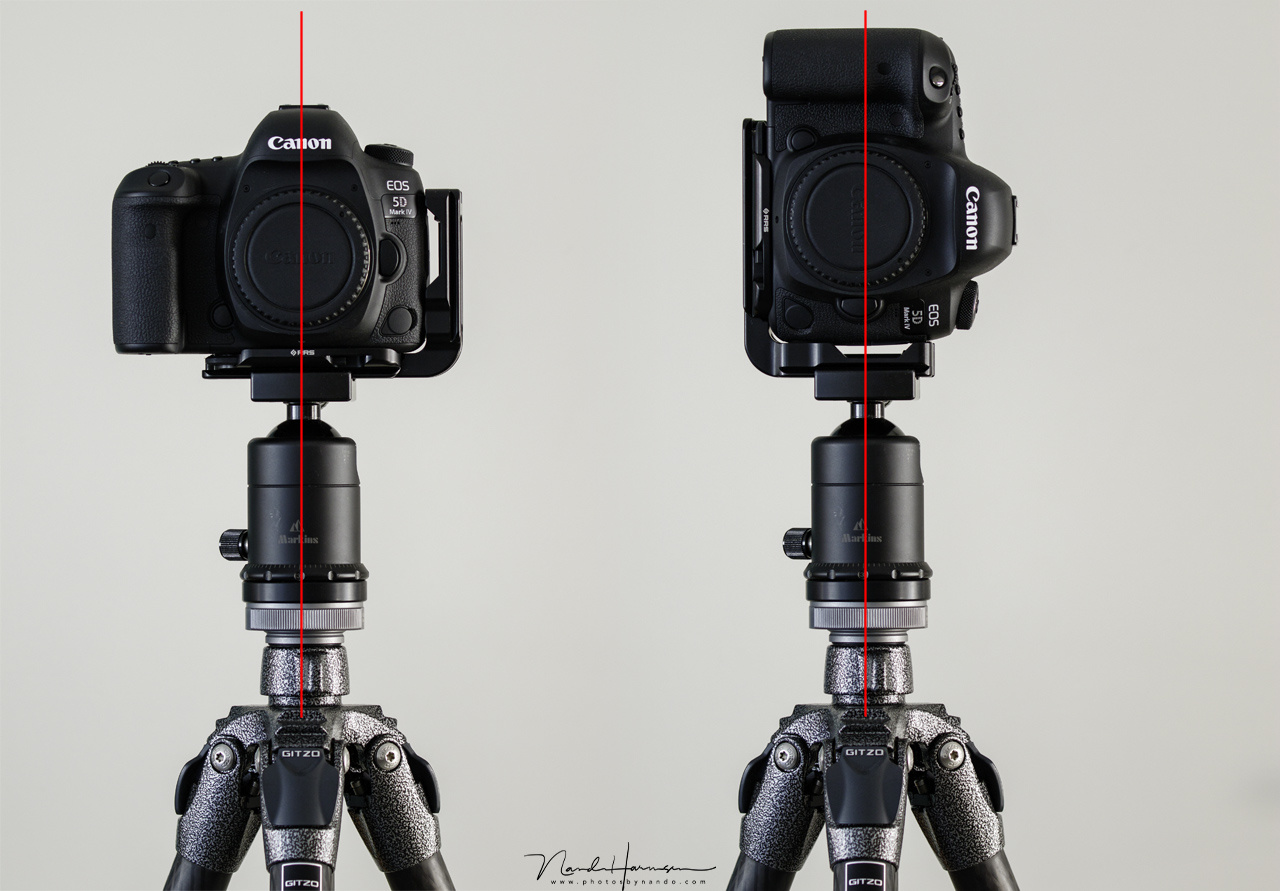
Using a L-bracket the camera stays above the center of the tripod, no matter what orientation it is in. It is much more stable, but also the composition is maintained.
I found the L-bracket very convenient in many situations. It made a lot of unusual tripod setups possible. I also have used a flash bracket for a while, keeping the flash above the camera when switching from landscape to portrait. Another benefit is the ease of panorama setups, reducing parallax with a nodal slide while holding the camera in portrait mode.

A rather unusable tripod setup, made very easy with a L-bracket. With a regular camera plate this would be much more difficult.

I once used a flash bracket for my wedding photography. The L-bracket made this modular system possible. Nowadays I use flash in a much more convenient way, without the need of these brackets.
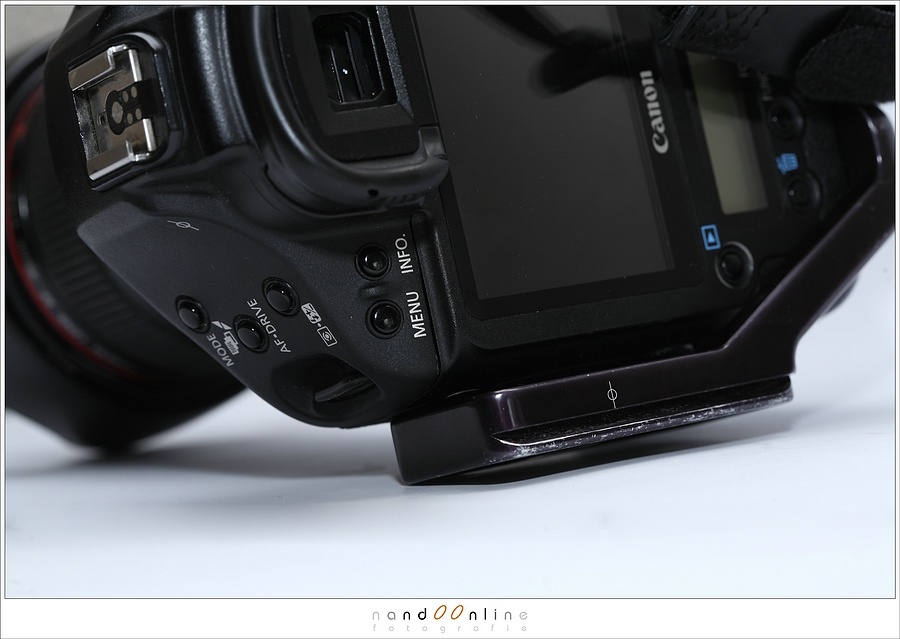
The L-bracket provided a lot of protection throughout the years. It protected the camera when it was placed on stage (concert photography) or a simple rock for support (landscape photography). The L-bracket got scratched, but not the camera.
Another nice benefit was the extra protection I got from the L-bracket. I could lean onto dirty surfaces without the risk of damaging my camera. It once even protected the camera from a fall onto a concrete floor, although that was also a bit of luck.
Nowadays L-brackets come in shapes and sizes. The best ones are the L-brackets that are designed for a certain camera model. These are also the most expensive L-brackets. The dedicated design makes it possible to reach every connection on the camera without the need of removing the L-bracket. The cheaper ones are often universal and may obstruct the use of cables or even battery compartments.
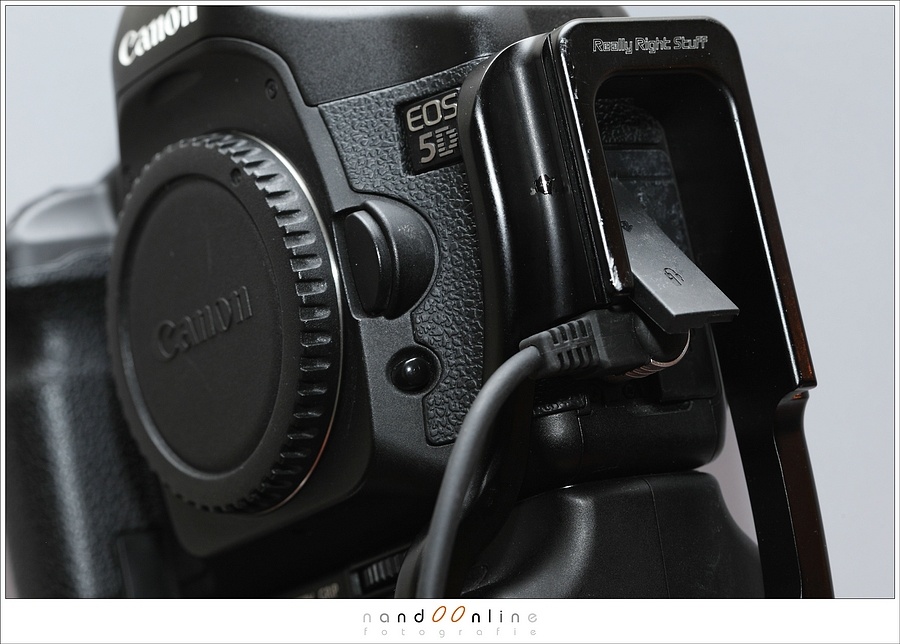
The camera specific L-brackets allow access to every port or connection on the camera. Just like the remote connected to this Canon EOS 5D, with the RRS L-bracket installed.
The L-brackets I use from RRS, and Kirk Enterprises, also have a normal tripod threat, so you still be able to connect straps like a Black Rapid or similar. This way you never have to remove the L-bracket from your camera. It just becomes part of it.
My Final Thoughts
After more than ten years of using L-brackets I know for certain it was one of the best choices I made concerning tripod connections. It made every new camera a bit more expensive, but it was well worth it. When my trusty Canon EOS 5D mark IV cameras have to be replaced, I am sure the next camera will also get that wonderful piece of metal called L-bracket.
What I Like About L-Brackets
- It is completely integrated to the camera body
- A good fixed connection to the tripod
- Composition will be maintained when changing from landscape orientation to portrait on a tripod
- Every compartment and connection slot will still be accessible
- Extra accessories can be used with a L-bracket like nodal slides, macro rails, and flash brackets
- Connection for Black Rapid straps or similar is still possible without removing the L-bracket
- Extra flexibility for positioning the camera with a tripod
- Extra protection
What I Don’t Like About L-Brackets
- The extra weight
- Expensive
- Every camera needs its own designed L-bracket
- Takes more space in a camera bag
These likes and don’t likes are about the more expensive L-brackets, that are designed with a certain camera in mind. Today cheaper L-brackets are available on the market. Some of these brackets are one-size-fits-all. But be aware, these brackets can obstruct accessibility, making it necessary to remove it every time you need to connect a cable, or to change a battery. These brackets are also sticking out, making it more voluminous.
If you use a tripod often, a L-bracket may be a very good choice for you. Most brands have Arca-Swiss compatible ball heads now, making it easier to use L-brackets on many different brands. The L-bracket may be a bit expensive, but I think it is well worth it.
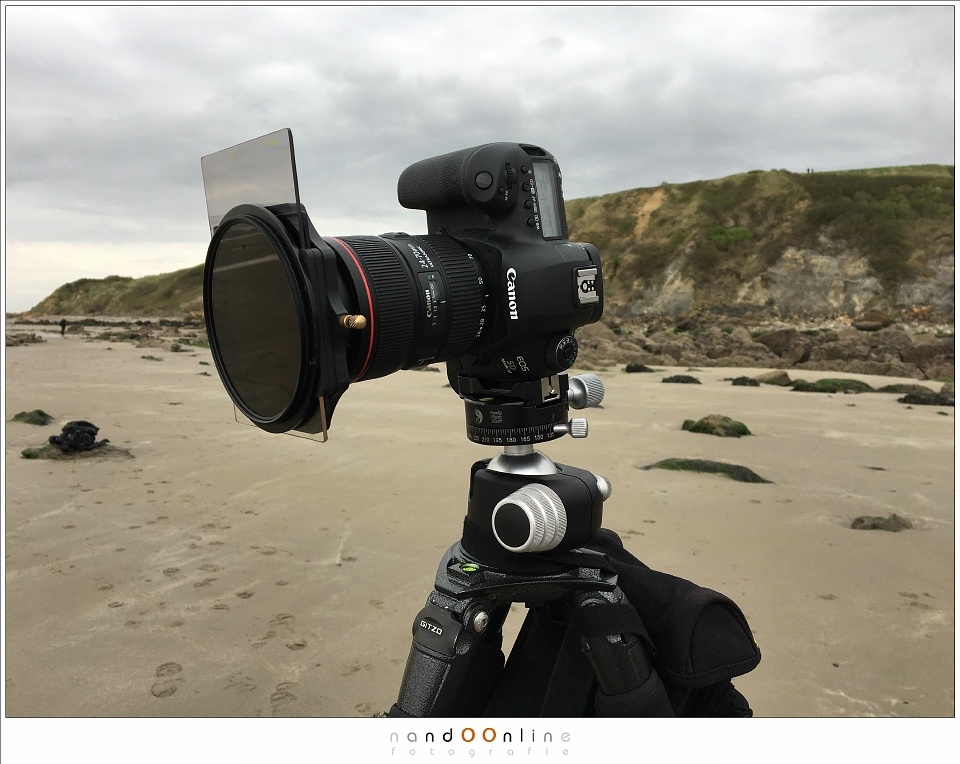
A real world example of a portrait orientated camera, with filters for a long exposure. The L-bracket makes this so much easier.
Do you use a L-bracket? Please let me know what brand and about your experiences. And if you never used a L-bracket, what do you think of it? Would you consider it? I would love to read about it in the comments below.








the one from ebay cost me $11 for my D800 and for my D4s it cost $45 shipped. been using for years and very happy.
If it works, it works. Amazing handy little thing, the L-bracket. Isn't it?
Some time ago I purchased an L-bracket by a brand called Sunway for my 6D. It wasn’t exactly dirt cheap at $60 and I was not happy with it: no matter how much I tightened the screw, there was some camera movement, especially in portrait with heavy lenses. Some thin sheet foam sandwiched between the plate and the body solved the problem, but still. (At the same time I purchased a Sunway Arca type plate for one of the tripods and that piece works OK, to be fair). Anyway, for the EOS R I purchased the RRS and everything is fine and dandy, super snug. [I now tend to avoid brands that have Sun, Moon, Stars, Pride, Honor, Great Wall and whatnot in their naming]
I heart about similar problems with L-bracket from Sunway from other photographers. Quite some list you are going to avoid ;)
Promediagear is also an excellent brand.
Ah, yes, from the flash brackets. Thanks. I forgot about it.
Also, they're great people with excellent customer service. Even better for me, they're very close to Chicago!
I paid 20 quid off amazon for one that’s designed to fit perfectly to the XT2, and includes a grip extension. Been using it for over a year and it’s in the same condition as it was when I bought it, sorry but I’ve got much better things to spend £170 on than 2 bits of alloy screwed together.
Also got a 3LT Ellie which is excellent but it hasn’t replaced the cheapo one on the Fuji, can use it on our other camera.
No need for excuses. If it works for you, it is perfect. Isn't it?
I hope everyone finds someone who loves you as much as Nando loves L-brackets.
Wondering if Tony deliberately took his profile photo in the same pose as the 'blank avatar' profile pic...
I do love my girlfriend even more :p
To be fair Nando you fall perfectly into the Gearhead 101 bracket perfectly.
-Canon/Nikon FF DSLR... check
-Super expensive Gitzo tripod... check
-Trinity f2.8 lenses... check
-RRS 2 pieces of alloy... check
-I’m guessing Lee filter system.. check
-some vastly overpriced rucksack... check
It’s like someone has written a guidebook on how Landscape photographers can spend 1000s of pounds as it’s the only surefire way of making good images.
At least he uses his gear.
Yes he does. and thats fair enough.
You forgot a few things.
:p
Funny, you mention an overpriced "rucksack". If it keeps my gear safe, it is a small price to pay. A new camera because the backpack fails is more expensive
Again its one of those things that i think you can invest a bit in, but when its say £180 for a Manfrotto pro line and £400 for Lowepro thats when we enter rip off territory.
i believe a certain fruit company have even managed to render their own unofficial slogan on the back of overcharging people, is it something like 'apple tax'? i dont think its fair that they are the only company who gets picked on for this, when there are plenty of others, particularly in our world that are doing the same, wacom cough cough.
I use Thinkthank bags, and it has kept my gear very safe. I wouldn't want to trust my gear with cheap bags... :D
See is the Manfrotto cheap? or just cheaper? at what point does the quality level out and the extra money means nothing?
Manfrotto is also expensive. Nothing is really cheap when you talk about gear from a larger brand. You also pay for the name.
Your question can not be answered very easily. It all depends on what it is. :)
Oh yeah i fully agree on that one, its definitely not an easy question to answer.
I had a 488 ballhead broken half after a few years (probably not more than 3) of use. It was stated to be able to hold 8 kg, and maximum load it had was 5kg.
I have a Foba Superball since then. 10+ years. Mechanically it is smooth and reliable. And I use it way more often with heavier setup than that cheap manfrotto.
Another example I had was my 454 macro rail, which started to degrade after a few year (due to bad design and weak material). As I'm not doing that much macro work, I did't replace it, but there are out there pricier and better options. For example I tried Novoflex and it felt good.
BTW: this very expensive RRS L brackets are super cheap compared to the Smart Flex L brackets.
I never heard about Smartflex before. But by the first look of it, these are very bulky. And way too expensive for my purpose. :)
what stewy doesn't get is that it is not only the quality and reliability of the product, it's ability to save you time during production, but how the company will stand behind their product if anything goes wrong. Thinktank and Apple are two companies that fit this bill.
Show us your work Yinny, lets see what you are getting with your expensive gear... mind you its hard to compose a shot when you are in your mums basement, with a smart phone.
oh, how original stuart little. did you come up with that all by yourself?
Nando, no reasoning with stuart little who is penny wise and pound foolish and kidn of person who buys cheap tires to save money. I use Thinktank since 2006 and theirgear is well worth the price. I just got the Mindshift BACKLIGHT® 18L and it is the best backpack I have purchased for mirrorless. It is light(2.5 pounds) and roomy enough for a9 with 100-400, 35mm/1.4, or 50/1.4 and a9 with 24-70/2.8.
I have two L brackets for my D7100. One for use with a battery grip and one without the battery grip. I have attached my Black Rapid strap to a quick release clamp so I can leave the strap attached when I use either the vertical or horizontal plate on either L bracket.
The Leofoto bracket I use with the battery grip has safety screws on both the horizontal and vertical plates, something I seldom have seen on other L brackets.
Yep, a very important piece of equipment for landscapers and studio shooters. I use profoto for GFX and RRS for XT3
I already find that a simple tripod plate is inconvenient in my camera bag (tight fit) so no way an L-bracket would make me happy... I do swear a lot though in some usually cold conditions when shooting in portrait and the plate rotates, happens more often than not but I learnt to live with it :-)
Im the same a bit, but the one i got for the XT2 is designed specifically for that camera so its nice and snug.. this means it can be packed with it attached, in fact it rarely comes off the camera.
That is the problem of any camera plate, regardless which type, L-bracket or something else. A lot of small and compact camera bags often have only room for the body without it.
Hey man, we need some reason to justify spending 170 quid on 2 pieces of alloy and an allen bolt, if he wants to leave his plate slightly loose to give that reason then leave him be:)
Or you have a L-bracket that does not fit very well ;)
I adopted a bracket for a different reason. RRS has this neat feature where you can attach a QD sling or strap to the bracket, and I use that for carrying my camera now. It seems way more robust than a Blackrapid or similar, and is super quick to get on and off the camera, very helpful for when I go from shooting freehand to locked down on a tripod.
I have been looking for those straps, but I was wondering if the connection is fool proof. I had my doubts.
But it is a nice system that looks very good.
I use Optech straps that click to the schoulderstraps of my backback. That way the weight of my camera is never on my neck, and it counter ballance the weight of the backpack.
Perhaps a good subject for another article... hmmm
But I understand it is a very good system of RRS, those QD slings?
It's pretty magical. The QD system was originally developed for military use to hold firearms, so there's a decent credibility to the setup. After a few months of using the Magpul strap on their website, I can say it's definitely more comfortable than any shoulder-based sling I've used, and I've used Blackrapid and Peak Design. It's a very positive lock when you snap it in, and I've really tried to push it seeing if there's any chance of my camera coming off accidentally. I've found nothing that could easily detach it.
For me there is no need for such a strap at this moment. But it is good to know. Thanks.
Nando, you should consider going back to Kirk. They make a “universal L-bracket.” It is an adjustable L bracket with an Arca Swiss adapter. It connects to any Arca Swiss mount or plate. I just buy a plate for every camera (much cheaper than L-brackets!) and leave the universal L-bracket in my bag ... getting it out when I need it, and not having to schlep it around all day, every day.
See: https://www.kirkphoto.com/camera-mounting/universal.html
Thanks for the suggestion. I have looked at it for a moment, but I cannot get a good picture how it should fit on a camera. It is universal, so I think some camera connections will not be accessible at all times.
But I will keep it in mind.
Relatively recent convert to the idea of an L plate.
The D850 is fitted with RRS base plate and removable 'L" The L bit lives in the camera bag in case I need it.
Z7 also has a bas place from RRS. to protect the base of the camera, to allow the FTZ to fit without bashing into a traditional tripod plate and it also extends the height of the camera which just adds enough to sit comfy in my hand.
My Kirk L-bracket saved my (brand new) D850 when I face-planted on a sidewalk last year. Like you I wouldn't be without one.
Rather than attaching a strap directly to it, I prefer to use an Acratech swift clamp. It allows me to change the attachment point of the strap as needed, including to the shoe of telephotos with Arca-swiss compatibility.
https://www.acratech.net/swift-clamps-for-black-rapid-cotton-carrier-by-...
Recognizable. :)
The Acratech is a nice one. I have something similar, for my spider pro holster
L bracket. Indispensible piece of kit in my opinion.
I once made love to my L-bracket. I used protection, and have never regretted it.
I have used the RRS L-brackets on my arca swiss C-1 heads with RRS clamps. It's a perfect consistent system for what i do. Also not flipping the camera around makes the head last longer and L Brackets can protect the camera in case you drop it on 2 of the 4 sides.
L plates are expensive for what they are but Ithink that has got more to do with small production quantities than anything else. It took me ages to find a plate for my 6D mk2 (yep, a mk 1 plate does not fit) and still let me get to all its holes.
When I did find one It turned out to be one of the cheapest.
It's been on my Camera ever since. Plays well with my Peak design goodies too. I suspect it adds some protection to the camera in a fall ( the roll cage someone mentioned).
The increase to the volume of the camera is minimal and I have no idea what it weighs - I don't have anything that can weigh things that light!
I l love it. The only thing that could be improved is the manufacturer's name; "Kakafoto" just feels all wrong!
You're joking... Kakafoto?
lol
This is the Kakafoto (!) L plate on my 6Dmk2
I like:
-The magnetically stowed allen key - very cool and it stays put.
-Plenty of places for my Peak Design anchors
-Spare threaded hole for Black Rapid type slings etc
-Price
Don't like:
-Slight limitation on the screen articulation. I haven't actually found it a problem. It may be why none of the big names --make a bracket for this model - just to difficult to clear the screen completely.